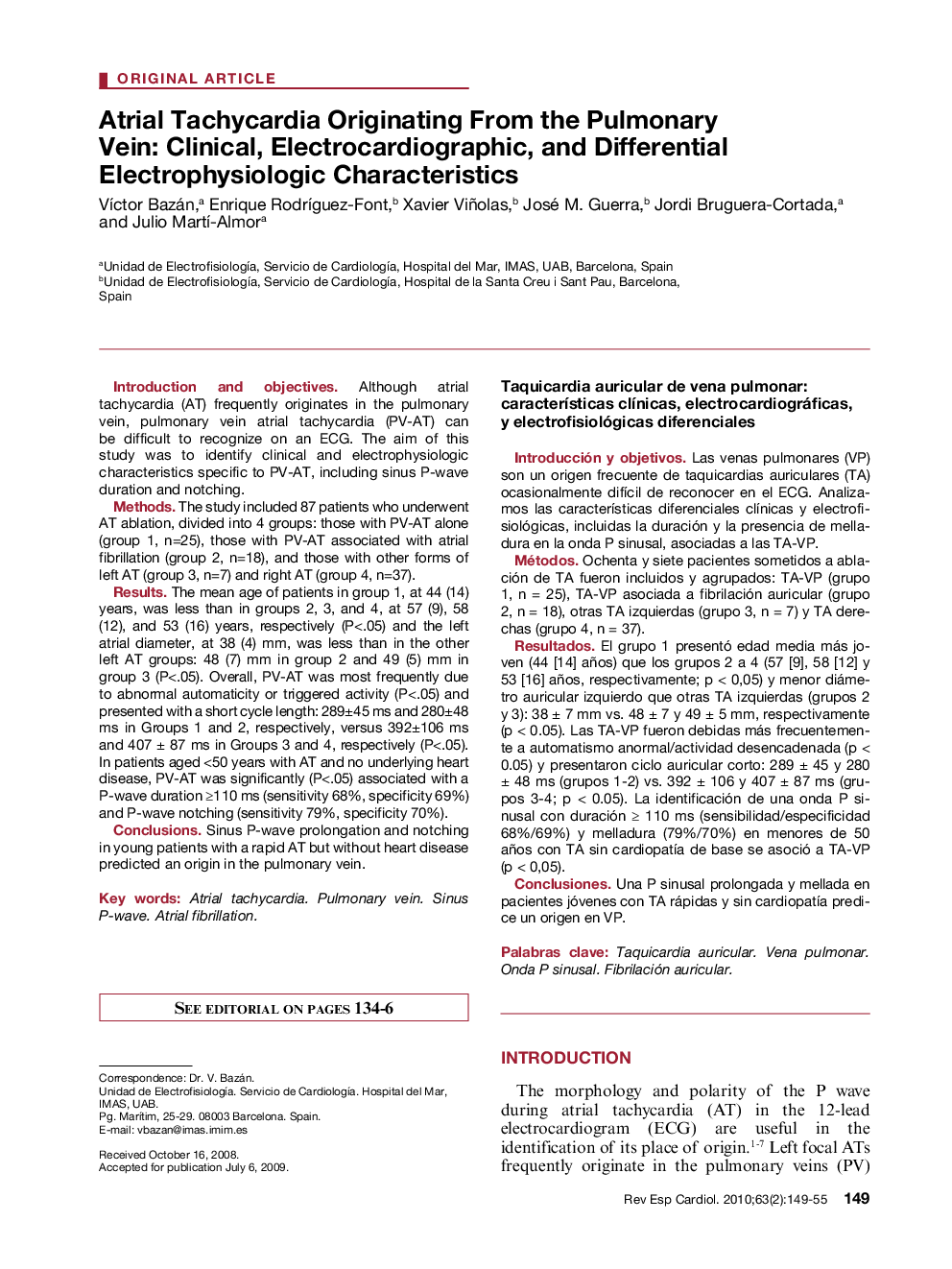| کد مقاله | کد نشریه | سال انتشار | مقاله انگلیسی | نسخه تمام متن |
|---|---|---|---|---|
| 3017324 | 1182115 | 2010 | 7 صفحه PDF | دانلود رایگان |

Introduction and objectivesAlthough atrial tachycardia (AT) frequently originates in the pulmonary vein, pulmonary vein atrial tachycardia (PV-AT) can be difficult to recognize on an ECG. The aim of this study was to identify clinical and electrophysiologic characteristics specific to PV-AT, including sinus P-wave duration and notching.MethodsThe study included 87 patients who underwent AT ablation, divided into 4 groups: those with PV-AT alone (group 1, n=25), those with PV-AT associated with atrial fibrillation (group 2, n=18), and those with other forms of left AT (group 3, n=7) and right AT (group 4, n=37).ResultsThe mean age of patients in group 1, at 44 (14) years, was less than in groups 2, 3, and 4, at 57 (9), 58 (12), and 53 (16) years, respectively (P<.05) and the left atrial diameter, at 38 (4) mm, was less than in the other left AT groups: 48 (7) mm in group 2 and 49 (5) mm in group 3 (P<.05). Overall, PV-AT was most frequently due to abnormal automaticity or triggered activity (P<.05) and presented with a short cycle length: 289±45 ms and 280±48 ms in Groups 1 and 2, respectively, versus 392±106 ms and 407 ± 87 ms in Groups 3 and 4, respectively (P<.05). In patients aged <50 years with AT and no underlying heart disease, PV-AT was significantly (P<.05) associated with a P-wave duration ≥110 ms (sensitivity 68%, specificity 69%) and P-wave notching (sensitivity 79%, specificity 70%).ConclusionsSinus P-wave prolongation and notching in young patients with a rapid AT but without heart disease predicted an origin in the pulmonary vein.
Introducción y objetivosLas venas pulmonares (VP) son un origen frecuente de taquicardias auriculares (TA) ocasionalmente difícil de reconocer en el ECG. Analizamos las características diferenciales clínicas y electrofisiológicas, incluidas la duración y la presencia de melladura en la onda P sinusal, asociadas a las TA-VP.MétodosOchenta y siete pacientes sometidos a ablación de TA fueron incluidos y agrupados: TA-VP (grupo 1, n = 25), TA-VP asociada a fibrilación auricular (grupo 2, n = 18), otras TA izquierdas (grupo 3, n = 7) y TA derechas (grupo 4, n = 37).ResultadosEl grupo 1 presentó edad media más joven (44 [14] años) que los grupos 2 a 4 (57 [9], 58 [12] y 53 [16] años, respectivamente; p < 0,05) y menor diámetro auricular izquierdo que otras TA izquierdas (grupos 2 y 3): 38 ± 7 mm vs. 48 ± 7 y 49 ± 5 mm, respectivamente (p < 0.05). Las TA-VP fueron debidas más frecuentemente a automatismo anormal/actividad desencadenada (p < 0.05) y presentaron ciclo auricular corto: 289 ± 45 y 280 ± 48 ms (grupos 1-2) vs. 392 ± 106 y 407 ± 87 ms (grupos 3-4; p < 0.05). La identificación de una onda P sinusal con duración ≥ 110 ms (sensibilidad/especificidad 68%/69%) y melladura (79%/70%) en menores de 50 años con TA sin cardiopatía de base se asoció a TA-VP (p < 0,05).ConclusionesUna P sinusal prolongada y mellada en pacientes jóvenes con TA rápidas y sin cardiopatía predice un origen en VP.
Journal: Revista Española de Cardiología (English Edition) - Volume 63, Issue 2, February 2010, Pages 149-155